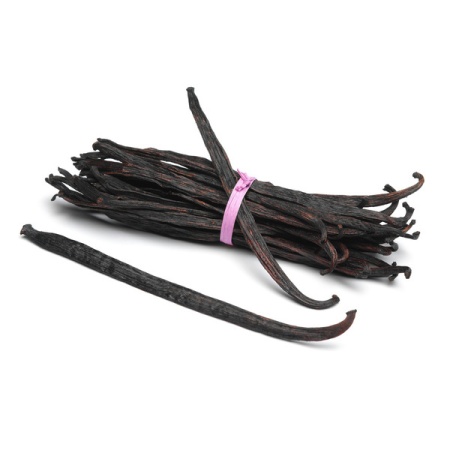Vanilla is a flavoring that is used in almost every sweet thing that we bake. The type and quality of vanilla is crucially important to the taste of our baked goods.
Vanilla can be used in either its original pod form, which is derived from the orchid plant, or the more commonly used extract, which comes in a bottle. The pod imparts a stronger flavor than the extract, and leaves behind tell tale dark specks. Vanilla pods are on the more expensive side, and require more effort to use.
The extract is made from macerated vanilla beans which have been soaked in alchohol and water, and then aged for several months before filtering. The FDA specifies that pure vanilla extract be made from 13.35 oz. of vanilla beans per gallon during the extraction process. Imitation vanilla is comprised of artificial flavorings, commonly paper industry by-products and chemicals. Bottles marked vanilla flavoring are made from a blend of extract and imitation vanilla. The faux versions tend to have a slight chemical flavor that is unpleasant.
For the best outcome in baking, stick with the real deal; either vanilla pods or pure vanilla extract. Although these are more costly, the outcome is well worth the investment. Remember, most recipes only call for a teaspoon or so.
When purchasing vanilla extract, look for a pure amber color. Clear or very dark liquid indicates that it is either a synthetic vanilla, or that dyes have been added.
One notable high quality commerically produced, commonly found vanilla extract is Nielson-Massey. There are many other very good vanilla extracts at slightly lower prices as well.
Store your vanilla extract in a cool, dark place, and make sure it is tightly sealed to avoid evaporation.
Ultimately, the two types of vanilla can be used interchangably. The rule of thumb is:
1 vanilla bean is equal to 2 tablespoons of vanilla extract.
You can also make your own vanilla extract, using vanilla beans and alcohol, such as vodka, bourbon or rum. Here is a great tutorial from The Kitchn.
Happy Baking!
Top photo: Glasshouse Images
Bottle photo courtesty of Nielson-Massey
Check us out at indigojonesnyc on instagram.
Want to see what we have been pinning? Take a look at our Pinterest page!
Tweet along on Twitter.
Take a peek at our Tumblr.
To keep up with the latest, show us some “like” by liking our Facebook page
Check out our new site Indigo Jones Eats
Tags: imitiation vanilla, kitchen tips Tuesday, Nielson-Massey, substituting vanilla extract for vanilla beans, substitutions, using vanilla beans for extract, vanilla, vanilla beans, vanilla extract, Vanilla pods


Leave a comment